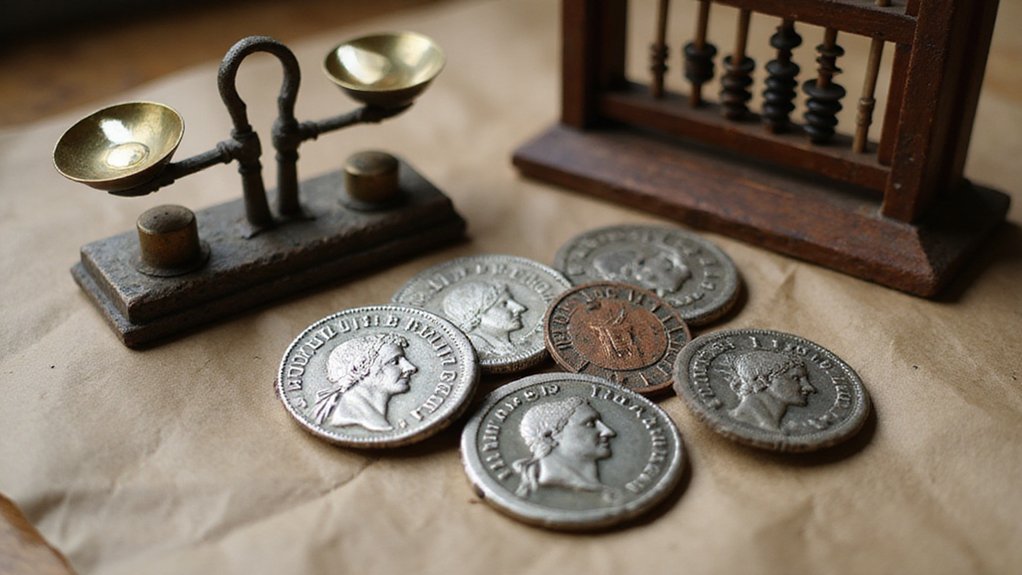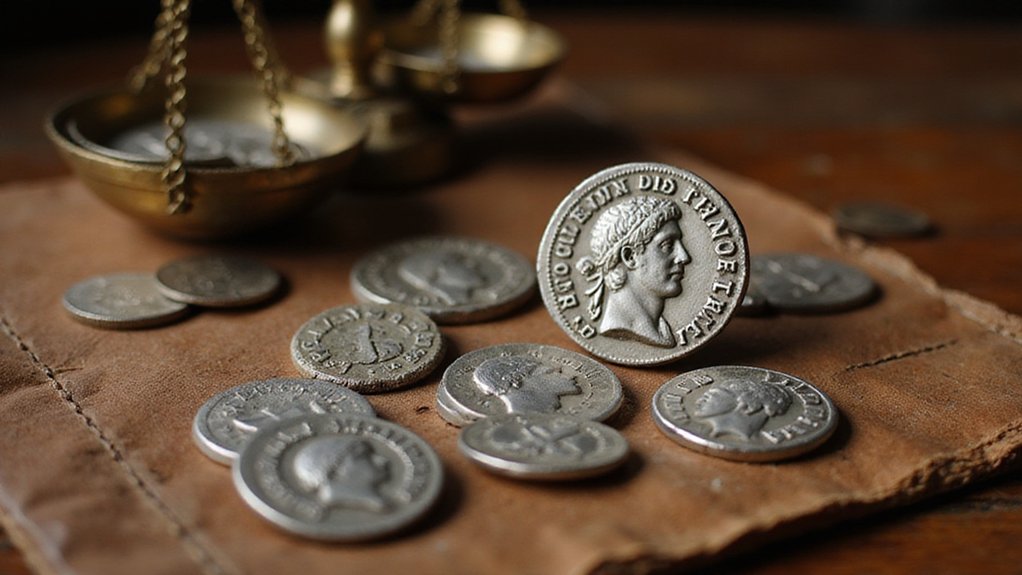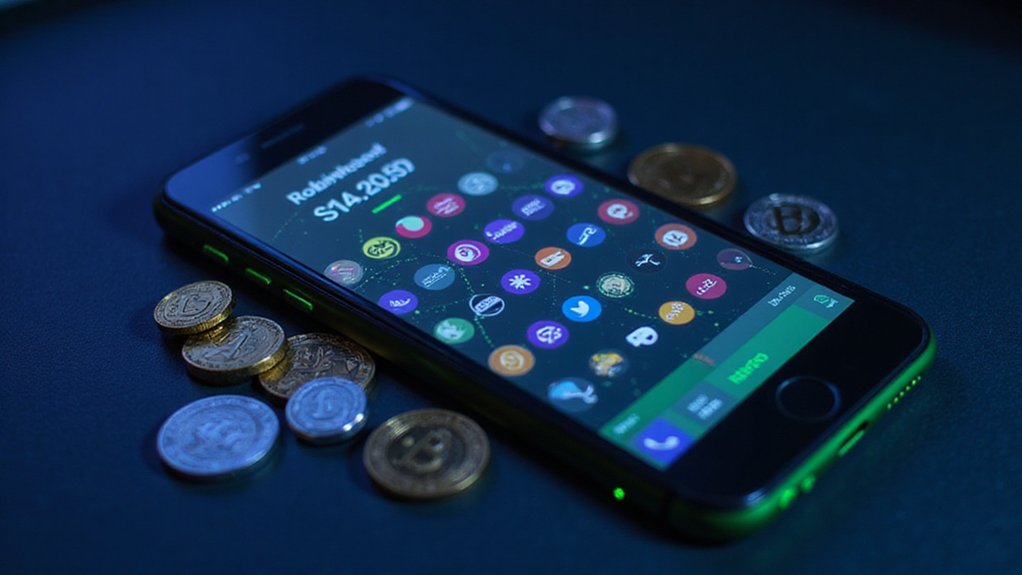The denarius, Rome’s silver workhorse, initially contained 4.5 grams of silver (211 BCE) before settling at 3.9 grams under Augustus. Worth one day’s labor in biblical times, it equated to approximately $20 in modern purchasing power (2013), though its actual silver content values at merely $3.02 (2023). Originally worth 10 bronze asses—hence its “tenner” etymology—it was later revalued to 16 asses. This monetary backbone’s four-century trajectory mirrors Rome’s fortunes, from robust silver to debased bronze.

What exactly did it mean when the Bible mentions “a day’s wages” in the form of a denarius?
To understand this ancient economic benchmark requires delving into the complex monetary evolution of Rome’s most enduring currency.
Introduced around 211 BCE, the denarius initially contained a substantial 4.5 grams of silver and was tariffed at 10 bronze asses—hence its etymological designation as a “tenner.”
The silver denarius entered Roman commerce as a “tenner”—4.5 grams of precious metal worth ten humble bronze asses.
By 141 BCE, the coin had been revalued to 16 asses, reflecting Rome’s pragmatic approach to monetary policy amid fluctuating metal values.
During Augustus’s reign, the denarius stabilized at 3.9 grams (1/84 of a Roman pound), establishing what economists might consider the currency’s “golden era”—though silver-era would be more technically accurate.
Nero, whose financial acumen proved less impressive than his pyrotechnic interests, reduced this to 3.4 grams, inaugurating a debasement trend that would continue with numismatic inevitability.
The debasement accelerated dramatically during the 3rd century CE, when economic pressures (imperial expansion, military expenditures, and treasury depletion) conspired to transform this once-reliable silver standard into something increasingly bronze-adjacent.
In contemporary terms, the pure silver content of an early denarius would be worth approximately $3.02 at 2023 prices—a fraction of its historical purchasing power.
But numismatic values transcend mere metal content; well-preserved specimens command $65-$189 in today’s collector markets, with prices varying based on emperor, condition, and historical significance.
The coin’s physical specifications remained relatively consistent: 18-20mm in diameter, featuring imperial portraits and propagandistic imagery that served as the ancient equivalent of monetary branding.
The economic significance of the denarius is evident in biblical contexts where it represented one day’s wage for common laborers, equivalent to approximately $20 in 2013 terms.
The denarius maintained its position as Rome’s monetary backbone for over four centuries before succumbing to inflationary pressures.
Its early designs featured the goddess Roma on the obverse and various symbols including the twin Dioscuri riding on horseback on the reverse, reflecting Rome’s religious and cultural values.
Its decline paralleled Rome’s own—by Aurelian’s reign (270-275 CE), the once-proud silver coin had devolved into a bronze shadow of its former self.
Ultimately, Diocletian’s monetary reforms abandoned the denarius entirely, closing the ledger on antiquity’s most influential currency experiment.
Frequently Asked Questions
What Materials Were Denarii Made From?
The denarius, initially minted from high-purity silver during the Republican period (c. 211 BC), underwent systematic debasement over centuries.
Augustus reduced its weight to 1/84 Roman pound, while Nero further trimmed it to 1/96 pound.
When Did the Denarius Stop Being Used?
The denarius’ demise was a protracted affair—a monetary sunset rather than an abrupt darkness.
While its functional relevance began waning during Gordian III’s reign (238-244 AD) with the antoninianus’ introduction, the venerable silver coin persisted in diminishing quantities through the early 4th century.
Official circulation effectively ceased during the Tetrarchy period (293-313 AD), though ceremonial mintings occurred sporadically thereafter.
The coin’s legacy, however, outlived its circulation, influencing terminology from the medieval dinar to modern monetary vocabulary.
How Did Denarius Value Change Throughout Roman History?
The denarius underwent a textbook case of currency debasement throughout Roman history.
Initially containing 4.5g of nearly pure silver (~95%), its trajectory resembles most fiat experiments—a slow descent into worthlessness.
Augustus trimmed it to 3.9g, Nero further reduced it to 3.4g, while maintaining reasonable silver content.
The real devastation occurred by the 3rd century when silver purity plummeted to a mere 2%, triggering hyperinflation where one gold aureus ultimately commanded millions of denarii.
Where Can Authentic Denarii Be Purchased Today?
Authentic denarii can be acquired through specialized online marketplaces like VCoins, Premium Ancient Coins, and Austin Coins, where prices typically range from $50 to $190 depending on preservation, rarity, and imperial association.
Traditional auction houses and numismatic dealers offer specimens with provenance documentation and third-party authentication services.
Buyers should prioritize vendors offering authenticity guarantees and detailed specifications (mint year, weight, diameter), while remaining vigilant about return policies—the numismatic equivalent of a financial safety net.
How Were Denarii Minted in Ancient Rome?
Denarii were manually crafted through a labor-intensive process that would make modern central bankers wince.
Artisans struck heated silver blanks (flans) between two engraved dies using hammers—one die fixed in an anvil, the other held above.
The resulting impressions typically featured imperial portraits and symbolic imagery.
Rome’s minting operations were remarkably centralized for a pre-industrial economy, with quality control maintained through official moneyers (tresviri monetales) who supervised production and, presumably, dealt with ancient counterfeiters through methods best left unexamined.









